I had one goal in mind when preparing for my trip to Athens,
see the all famous Acropolis and Parthenon.
Due to luck and good timing my day in the capitol of
Greece turned out
to be filled with touring much more than this one famous monument, much to my
delight.
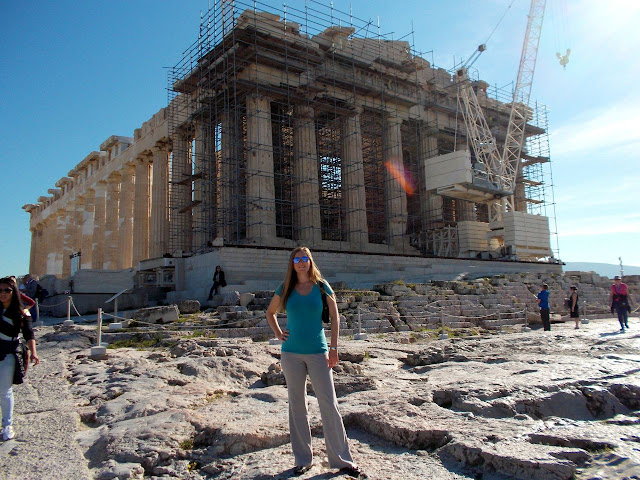 |
A little disappointed the face of the parthenon was covered in scaffolding during our visit, but I was not going to pass up a photo opportunity.
|
I visited Athens via cruise ship docked in the nearby
Piraeus. Piraeus is the largest port in
Europe and a city as old as Athens. A
day in Piraeus would be a day well spent in its own right, but this was my
first opportunity to visit Athens and I would not pass up an opportunity to see
that world famous city only a few miles away.
Our original plan to get to Athens was to take the public bus from the
cruise port to the metro that runs from Piraeus to Athens. We visited at the end of the cruise season
however, and arrived in the port of Piraeus to find the bus to the metro no
longer running for the season. It would
be a thirty-minute walk to the metro, not the best use of our limited time.
 |
| Visitors access the acropolis through these steps and hall of columns. |
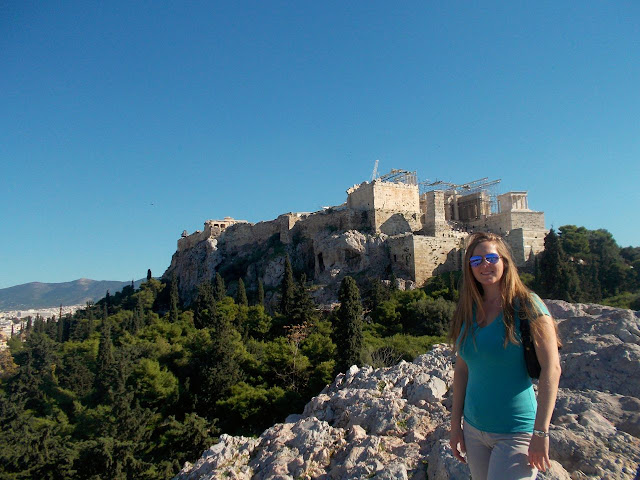 |
| The acropolis is the entire high hill behind me where the parthenon and other temples are located. The acropolis can be seen almost anywhere in the city. |
An employee of one of the three hop on hop off bus companies
came over to us as we stared puzzled at the closed bus ticket office and
explained the situation. Thankfully he
offered us an affordable alternative in a daily hop on hop off bus ticket (or
get on get off as that specific company called it). The ticket allowed us access to two routes
between Piraeus and Athens and around Athens itself. I was happy with the optional stops and
narrated tour, but I was terrified by the driving. Looking at the cool as a cucumber driver I
would never have thought he was flying through the crowded streets barely
missing the tiny fiats surrounding the double decker bus, and tailgating worse
than I have ever seen in my life. After
getting off on the first stop, before which we rode to in the front seat, I made a
mental note to sit as close to the center of the bus as possible. I wanted to be as far away from possible
points of impact.
 |
| The Panathenatic Stadium (left) and Temple of Zeus (right) as seen from the acropolis. |
 |
| The only ceiling still intact enough on the acropolis to make out the cubic reliefs. |
We disembarked at the Acropolis. Acropolis means high point of the city, and
its shape can be seen from all over the city as I would learn later that
day. It seemed whenever I looked up I
could see the Acropolis off in the distance.
Access to the Acropolis requires entering through the series of slippery
marble steps and columns, currently under restoration. The only access point to the hilltop, which
is surrounded on all other sides by a sheer drop off, acts as a bottle neck to
the no doubt thousands of visitors who come daily to this ancient site.
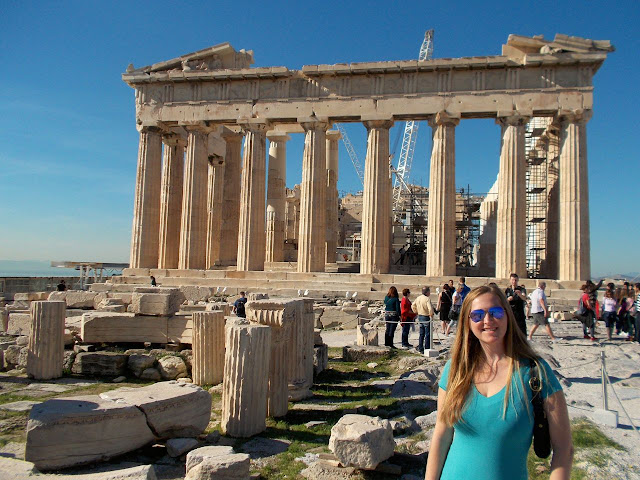 |
| The scaffold free back of the parthenon. |
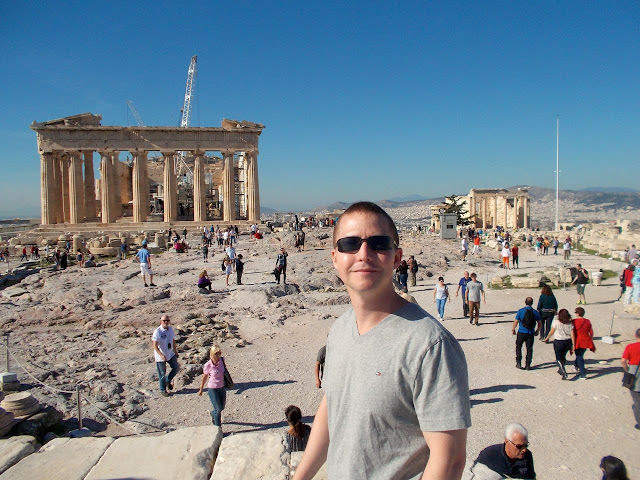 |
| David enjoys the view of the entire top of the acropolis. |
Once we cleared the bottleneck like entrance the Acropolis
opened up to a large clearing containing the two monuments built by classic
Greeks to honor their gods and city, the Parthenon, the Temple of Wingless
Victory (the first temple built on the Acropolis), and the Erechtheum (a third temple dedicated to Athena and Poseidon.
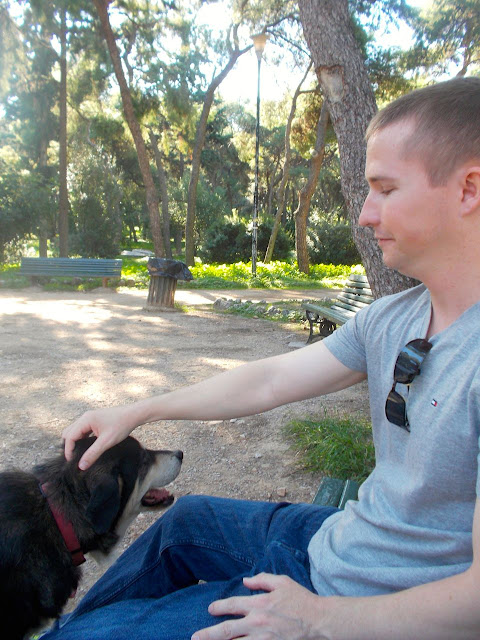 |
| Friendly family dogs wander freely in Greece. David pets this one who said hello while we waited for our bus. |
The Parthenon was unfortunately covered in scaffolding since
it was undergoing restoration. I would
have been upset about the scaffolding ruining all my photos of the monument, had
I not seen what bad shape the Parthenon is in.
I realize this monument has been standing for over two thousand years, but I did
not expect the roof to be completely missing.
The only parts of the structure remaining are the exterior columns and
the floor, much less than I expected.
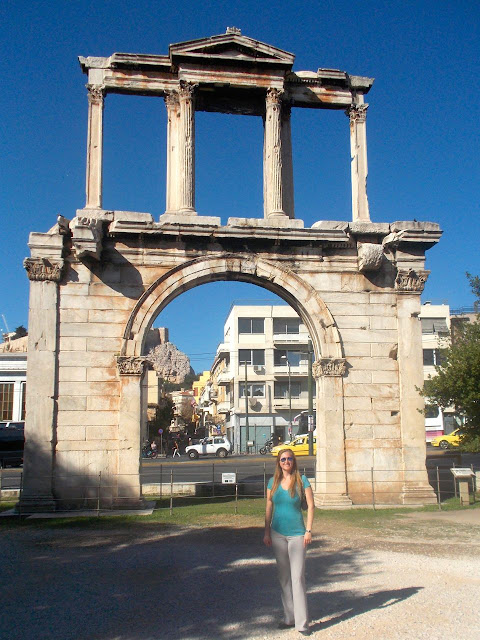 |
| Hadrian's arch stands behind me across from the mammoth columns of the Temple of Zeus. |
I think all of the photos used in history channel specials
and promotional materials show the Parthenon from the front, which due to its
large facade gives a fools the observer into think the structure is more
complete than it really is. What the
Parthenon lacks in structure the Temple of Wingless Victory and Erechtheum make
up for. These structures still contain
enough of a ceiling and decoration to make it easy to imagine what they would
look like whole.
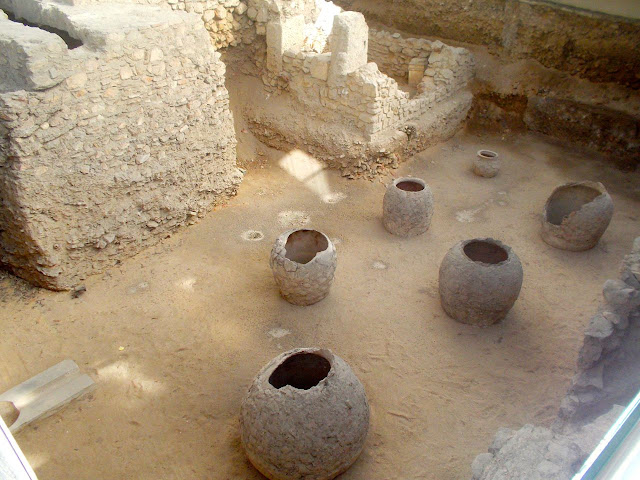 |
| These archaeologic remains were discovered in the botanical gardens while installing a ventilation shaft for the subway system. |
The Acropolis offers more than Greek monuments to the
observer willing to climb its stairs to the summit. The treeless terrace of the summit offers a
three hundred-sixty degree view of Athens below. From the summit, we could see the Panathenaic
Stadium where the first modern Olympic Games were held in 1896, and the remains
of the Temple of Zeus down the street. On
the opposite side of the plateau, we could see the park that surrounds the
Acropolis, with its temples, ancient ruins, and ancient streets now used as
pedestrian walkways. We could even see
the cruise ship docked in Piraeus.
 |
| Ruins that will have to wait until we return to explore more of Athens. |
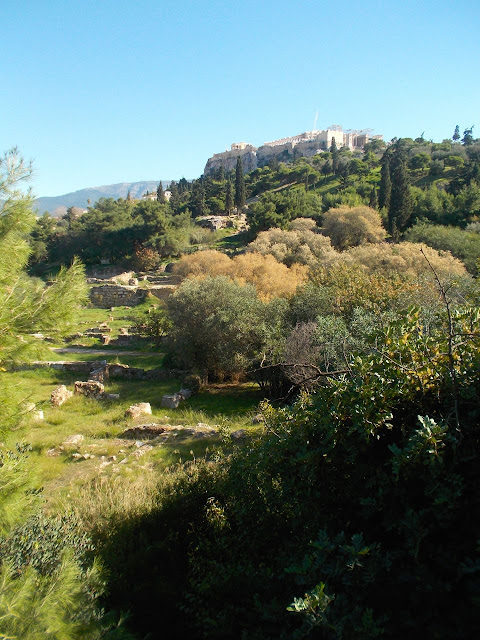 |
| The acropolis looms above this park in Athens. |
The weather in Athens was perfect in the mid seventies, with
sunny skies. After leaving the Acropolis
we spent as much time walking around the many green areas of the city as riding
the get on get off bus. We made a loop
of Hadrian’s Arch (supposedly built to honors the emperor Hadrian and separating the ancient city from the temple complexes), the larger than life remains the Temple of
Zeus, the Panathenaic Stadium, and the National Gardens before arriving just in
time to see the changing of the guard in front of the parliament building. We purchased some roasted nuts from a street
vendor as we watched the slow motion kicks of guards in fanciful uniforms during
the ten-minute ceremony.
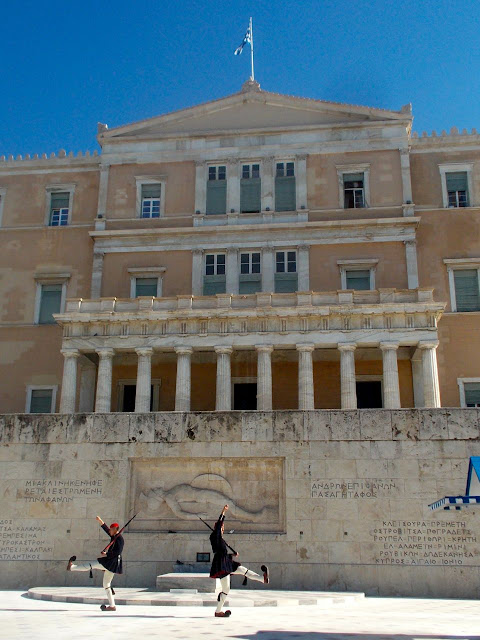 |
| Slow rolling kicks are the signature move in the changing of the guard in front of the Greek parliament. |
In reality purchasing nuts was a tasty but unnecessary
purchase, as trees both within the National Gardens and all over the city were
full of citrus. Citrus trees were so
plentiful and bountiful fruit was rotting on them before it could be
picked. Citrus trees were not the only
fruit trees we saw plentiful in Athens.
After riding the bus from the Parliament to the park surrounding the
Acropolis for a leisurely stroll along the old Greek roads we saw olives just
ripening hanging from trees throughout the park. They were hard to see at first as their green
color and small shape hid the olives among the leaves, but once we noticed the
first bunch I looked around again to seem them hanging everywhere.
 |
| Citrus trees are abundant with fruit all over Athens. We found these in the National Gardens. |
 |
| An olive tree we passed in Athens. Legend has it the goddess Athena gave the citizens of Athens the olive tree as a gift. |
Aside from olives and olive trees, the park was abundant
with locals selling jewelry and art.
Cafes with outside seating lined the busier sections of the walkways. Despite much of the park bordering the rougher
section of town, I never felt unsafe.
Firemen and other public servants stood watch in strategic locations
along the walkway, ensuring the safe environment for tourists and locals alike
to enjoy the perfect weather. As Athens
is home to a third of
Greece's population, green spaces like this park offer an
oasis within the city from the urban sprawl.
 |
| David walks through this park past vendors selling trinkets and jewelry. |
We found Athens an affordable port stop. Between out hop on hop off bus ticket
(fifteen euros each), ticket to the Acropolis (twelve euro each), and the nuts
we bought for a snack (a euro and a half each) we enjoyed a full day in the
city for less than the cruise ship was charging for a visit to the Acropolis
alone (eighty-five dollars a person). We
also had the freedom to adjust our plans, squeezing in more sights like the
changing of the guard as the day went on, freedom lacking on a cruise ship
excursion. The people of Athens were
friendly, and the bus company employees all spoke impeccable English. Employees were stationed at all the stops
ready to sell tickets or answer questions.
Given the opportunity, I would not change the time we spent in Athens in
anyway.
 |
| Can you make out the cruise ship and Acropolis in these photos we took? |


















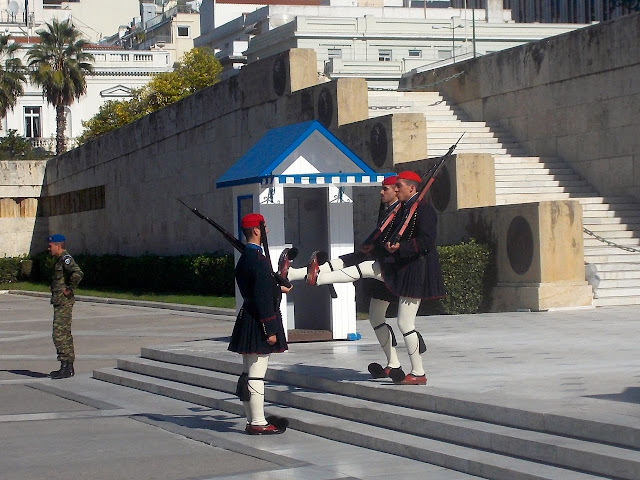
No comments:
Post a Comment